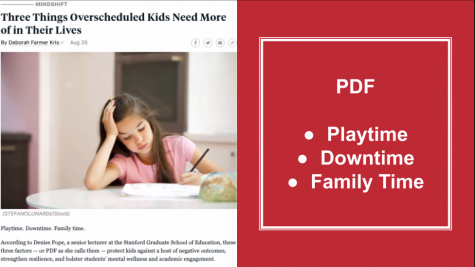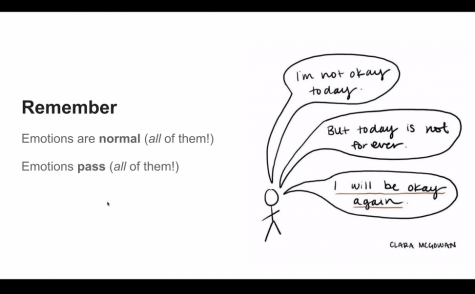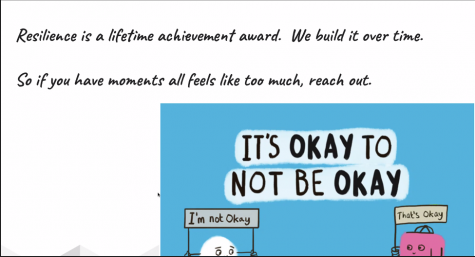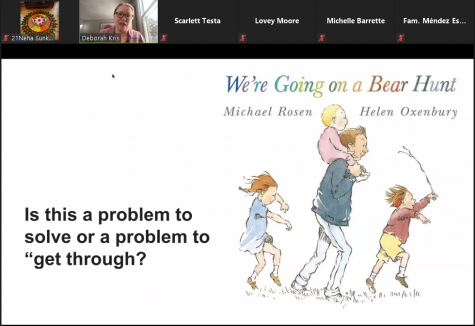Quick Takeaways from Workshop #5: Stress
How many times have you used the word stress this week? If it is more than once, you are not alone. According to Finances Online, 45% of high schoolers report that they always feel stressed. But, Dr. Susan David, the author of Emotional Agility: Get Unstuck, Embrace Change, and Thrive in Work and Life, writes that discomfort is the price we pay for a meaningful life. Though there is no way to eradicate stress from our lives, we can still find small ways to be resilient against stress. In her fifth and final Habits of Mind workshop about Making the Best of Stress: Building Your Resilience Toolbox, Associate Director of Montrose’s LifeCompass Institute Mrs. Kris shared five strategies for managing stress.
Stress is a normal, biological response to perceived threats and challenges. Stress gets us ready to act and to protect ourselves and our loved ones. We share this with all living creatures. Humans have a trium brain: the reptilian brain (instinctive), mammalian brain (emotional), and the new brain (analytical). The reptilian brain gives us our instinctive behaviors of fight, flight, or freeze, which are common responses to stress. The mammalian brain gives us our ability to love, connect, and take care of each other. The analytical brain allows us to dream, imagine, and plan as if things are occurring in the present moment.
Our stress response is like a fire alarm, which comes from the reptilian brain, and a watchtower, which is a distinctly human part of our brains. The fire alarm alerts you when something is a threat, while the watchtower observes the threat and deems if it is truly a problem. The fire alarm and watchtower need to work together to determine whether something is a problem. For example, if you are taking a math test and your internal fire alarm goes off because of a question on the test, your watchtower needs to take over so that you can finish your test.
So what helps to manage stress?
- Get Curious!
Get curious about your emotions. Whenever you feel a positive or negative emotion, stop and pause. Take a second to acknowledge what you are feeling. “I notice that I am feeling _____.” Then, take another moment to ask yourself, “Where is this feeling from? What will help me feel 1% better?” Last, honestly determine if this is a problem to solve or a problem to “get through.” Sometimes we just need to talk out or get through our problems instead of solving them. But remember that avoidance feeds anxiety. Your brain imagines that the English paper that is due next week is so big that you do not have the capacity to do it. Another quick strategy is to eat your frogs first. I know this sounds weird, but it is metaphorical. Do what is hardest first, since, after the hardest work is over, you will be relaxed and motivated to do other things. Spoiler alert: pomodoros are super helpful for getting work done!
- Keep Emotions in Perspective
During your teenage years, you experience your second major growth spurt (the first is when you are a baby). Your emotional brain grows larger and is enhanced, so your highs will be higher and your lows will be lower. The number one thing to remember is that ALL EMOTIONS ARE NORMAL! All emotions pass like waves, even the happy ones. But, we need to address what to do to “get through” them while in the middle of a wave.
A funny fact about humans is that we tolerate physical pain more than emotional pain. When we stretch before we play a sport, we are comfortable with the pain that comes from stretching a little bit more. Just like stretching, stress is strength training. While you feel stress, you are creating brain chains. For example, if you have a vocab quiz coming up that you are stressed about, just remember all the vocab quizzes you have conquered before. If you did it before, you can do it now.
Another little, but very effective, strategy is to ask yourself: “Can you be brave for ten seconds?” When you are avoiding an assignment, this strategy can be very helpful. Just pull out your phone and set a timer for any amount of time you want to. Then, ask yourself — “Can I be brave for this amount of time?” — and finish your assignment!
- Turn Down the Fire H.O.S.E.
By eating, unitasking, sleeping, and exercising, you can reduce your sleep. The H in H.O.S.E. stands for hunger. Yes, being hangry is a thing. For example, an Israel study actually found out that judges give harsher rulings when they are hungrier. The O stands for overstimulation. The brain is not made for multitasking. A strategy Mrs. Kris shared with the participants of the workshop is “to notice and relax.” Sit in your chair with your feet touching the ground and notice your feet and relax your feet. Notice your shins and relax your shins. Slowly move up your body while noticing and relaxing and begin to breathe deeply. The S stands for sleep and the E stands for exercise, both of which Mrs. Kris discussed in her last workshop.
- Breathe
Breathing is one of the few things that humans do consciously and unconsciously. Deep breathing is the number one in-the-moment helper for stress. Breathing helps to calm your fire alarm and strengthen your watchtower. Deep breathing sends an all-clear message to your brain and tells it to calm down. Practicing breathing actually helps you handle stress better. There are many apps and videos that promote deep breathing, including Calm, which Mrs. Kris used during the workshop.
- Make Time for PDF and Joy Drops
PDF stands for playtime, downtime, and family time. Connecting with people is a HUGE stress reliever. For example, an eight-second hug releases a flood of good hormones in your body (After the workshop was over, I gave my parents a giant hug). Other ways of connecting include snuggling with a puppy, calling a grandparent, and meeting with friends.
Joy-drop-moments are moments when you remember the small things which bring you joy. For example, watching the sunset, coloring in a coloring book, and listening to a playlist of songs that bring you joy. Some examples that the participants of the workshop shared are baking, stargazing, sewing, painting nails, and crocheting. Nature, light, laughter, and hugs are four additional sources of joy-drops. Also a joy-drop is something you can do everyday, that doesn’t cost money, and that you look forward to. Make a list of your own joy-drops and integrate them into your schedule so that you have something to look forward to each week.
If you don’t feel resilient right now, it is okay. A study by the Center on the Developing Center at Harvard University reveals that resilience is something we build over time. As Mrs. Kris puts it: “Resilience is a lifetime achievement award.” If there is a moment in which you aren’t feeling resilient, reach out to someone and follow these five strategies from Mrs. Kris to overcome your stress.
Lunchtime Leniency: Judges’ Rulings Are Harsher When They Are Hungrier – Scientific American
Meditation for Stress – Headspace
32 Student Stress Statistics 2020, High School, College Stress Statistics (financesonline.com)
Neha Sunkara ’21, Food and Wellness Editor
21nsunkara@montroseschool.org










